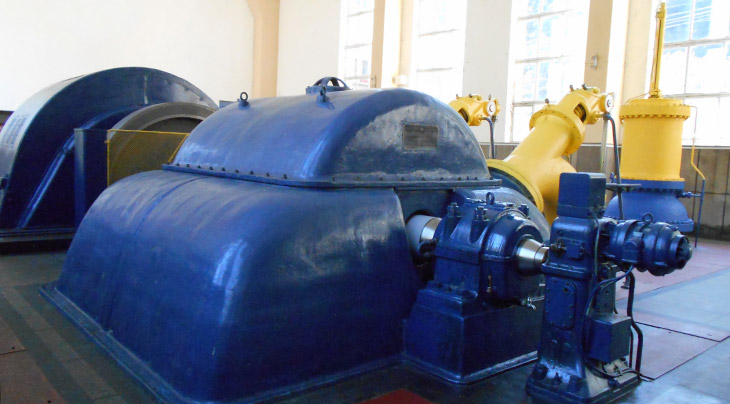###author###
Romanian hydropower has made its debut at a relevant scale, economically speaking, with electrification. Between 1950 and 1960, the development of Ialomița River was an opportunity for a number of technical achievements and set on Ialomița Valley several hydrotechnical objectives worthy of being mentioned in engineering manuals. Even before them, however, three hydropower plants made history in Romania. We saw them in action, together with young energy specialists, members of the Future Energy Leaders Program (FELP), of the Romanian National Committee of the World Energy Council (RNC-WEC)
The hydropower station in Moroieni has been active for 61 years, that in Dobrești – for 84 years and that in Sinaia is 130 years old.
All three units show that, properly maintained and used, the equipment can operate at normal parameters even decades after exceeding the estimated lifetime when they are out of the factory. Performance is even more impressive as everything has been achieved by manual measurements and instruments, and not by means of high precision robots watching the assembly line.
The technical monument in Dobrești
Dobrești hydropower plant was built between 1928 and 1930. With an installed power of 16MW, it was at the time the largest development of this type in Romania, position lost in favor of the first hydropower unit started at Stejaru hydropower station in Bicaz, in 1960. The unit is supplied from the water reservoir of Bolboci dam, processed water and by Scropoasa hydropower station, with an installed power of 12 MW. Dobreşti hydropower plant was the first plant in Europe equipped with Brown-Boveri automation equipment. It operated continuously until 1976 and acts as a technical monument. In the Control Room, one can still find the photo of teacher Dorin Pavel, nicknamed the „father of Romanian hydropower”, responsible for coordinating the construction. With small repairs, the four Pelton turbines of the hydropower plant work as in the first days of life and use much of the original components. Money for Dobrești plant and for the transmission network was ensured by Bucharest Municipality. Energy was transported to the transformer station in Grozăvești on a network equipped with 4 conductors, from Dobreşti to Târgovişte, and with 6 conductors, from Târgovişte to Bucharest. In Târgovişte, the line was connected through a transformer station from 60 kV to 110 kV with the line of 60 kV coming from Schitu Goleşti.
Moroieni – the connection between Transylvania and the former Kingdom
At a distance of approximately four kilometers from Dobrești, on a road difficult to cross by car, is Moroieni hydropower plant. It was inaugurated in the first half of decade 1950-1960 and has by 1MW less than Dobrești. The hydropower plant was a Romanian-Russian initiative. The two turbines, of 7.5MW each, were provided by the USSR, but produced in Austria. Generators were of Russian manufacture, as well as wiring and transformers.
This technical jewelry was modernized in 2003 with Romanian equipment, on the occasion of celebrating half a century from its commissioning. Back then, the station made the connection between Transylvania and provinces in the former Kingdom. Here, not only Moroieni power plant injects energy into the network, but also Dobrești and Scropoasa, and two lines reach Sinaia and Fieni.
Sinaia 0 – hydropower plant from the time of king Carol I
Sinaia Zero hydropower plant is an exhibit of life museum due to its seniority in the system and its capacity to work perfectly. It was commissioned in 1884 by The Romanian Society for Electrical and Industrial Enterprises, by the development of Prahova river, and represents a real jewelry of the 19th century. The hydrotechnical project was conducted by famous engineer Elie Radu.
The 1 MW power plant was at its inauguration the largest electricity producer in the country, with a three-phase production at today’s frequency of the national system, 50 Hz. The power plant has four groups of 240 KW each, the last being added in 1901. Of the four groups installed, only one is not of the original ones, after it was changed near 1930 with another, with higher returns.
Peleș Castle first took its electricity necessary for consumption from Sinaia 0 hydropower plant, the first in the series of small power hydropower plants that make up Prahova development: Peleș, Sinaia 1, Sinaia 2 and Sinaia 3. In 1899, the hydropower plant was connected to Doftana thermal power plant by a line of 8 kV, on wooden poles.
Horizontal Francis turbines of 3,600 horsepower were manufactured by Voight, being the first turbines of this type installed in Europe, and electrical generators were manufactured by AEG and Siemens AG & Sachsenwer. Due to the conservation of original equipment, the representatives of the three companies asked them, offering in turn their modern options. The offer wasn’t accepted by the Romanian side. In a section of the hydropower plant’s building, there’s also a museum of antique energy equipment made in Romania. The mechanical technique used in all the three objectives is complete and some of them continue to produce energy, to the astonishment of engineers and those who visit them. Thus, the young people from VLER and each of us have within reach an entire industrial tradition stored in metal and stone, a solid foundation for future careers and successes.
—————————————————-
The full version of this article can be read in printed edition of energynomics.ro Magazine, issued this November.
In order to receive the next issue (March 2015) of energynomics.ro Magazine for free, we encourage you to write us at [email protected] to include you in our distribution list.
